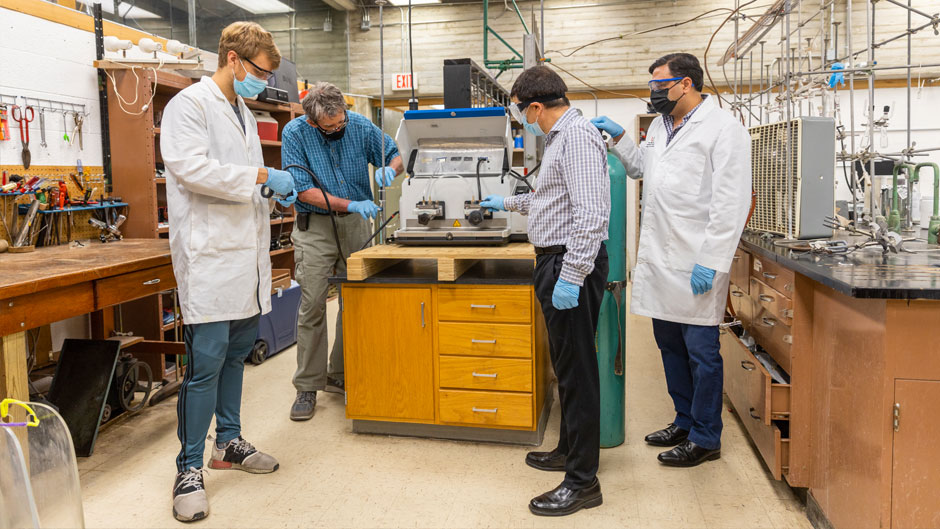Known as laughing gas, nitrous oxide is no laughing matter. The potent greenhouse gas emitted during the production of fertilizer is 300 times more harmful than carbon dioxide, forcing industrial factories all over the world to spend a lot of money and energy to dispose of the waste byproduct.
But in a breakthrough that one day might enable farmers to produce their own fertilizer from recycled waste, University of Miami chemists Carl Hoff and Burjor Captain have shown for the first time that it’s possible to convert nitrous oxide into potassium nitrate—a key component of the fertilizer needed to feed half the world’s population.
“Right now, the process is slow. To get a 50 percent conversion takes 50 hours,” said Hoff, a professor in the Department of Chemistry. “So, it is inefficient, and the yield is small. But we’ve shown that it can be done, and that is a big deal. Before, we had zilch. Now we have a solid that absorbs nitrous oxide and turns it into nitrate. So, we are taking something that you would pay money to get rid of and turning it into something that you would pay money to get.”
Their breakthrough, for which they have applied for a patent, flips the century-old method of cleansing nitrous oxide (N2O)—which is used in medicine for its anesthetic effects but threatens the ozone layer when emitted in industrial plants—on its head. Instead of using the tried-and-true method of removing the oxygen from nitrous oxide to turn it into nitrogen gas, the chemists piled the oxygen on, eventually producing potassium nitrate.
That result, which was surprising and unprecedented, raises the possibility that the chemists are closing in on a viable alternative to the process that German chemist and Nobel laureate Wilhelm Ostwald invented to neutralize ammonia and turn it into nitric acid, which is a nitrate. Patented in 1902, the high-temperature, high-pressure Ostwald process continues to be used in tandem with the process another German chemist and Nobel laureate, Fritz Haber, developed to convert atmospheric nitrogen and hydrogen gas to ammonia. Their combined discoveries provide the ammonium nitrate fertilizer that has helped feed the world for more than a century.
But as Hoff and Captain noted, the Ostwald process is expensive, wasteful, and dirty. It produces nitric acid by burning half the ammonia produced in the Haber process—usually with coal—and leaves behind nitrous oxide, and two noxious gases, nitric oxide (NO) and nitrogen dioxide (NO2), that contribute to acid rain. All three gases evolve any time ammonia is burned, but nitrous oxide is the most difficult to remove.
So, three years ago—with a $425,000 grant from the U.S. Department of Energy’s Office of Basic Energy Sciences—Hoff, Captain, and their graduate students began testing ideas for developing a greener, more efficient alternative to the Ostwald process’ method of removing nitrous oxide. But none of their experiments, which were disrupted by the global COVID-19 pandemic, showed promise until last November. That’s when the chemists began using lower temperatures, alkali salts, and a mechanical ball mixer—which beats compounds into more reactive nanoparticles by smashing a one-inch ball against the container 35 times a second.
The combination of those three changes would prove critical. On Jan. 16, Hoff, Captain, and graduate students Jack Davis and Oswaldo Guio confirmed that, after about six hours in the ball mixer, different salt mixtures and reaction conditions were able to trap and bind the nitrous oxide gas. That was a major breakthrough. But there was an even bigger surprise: as the mechanical pounding continued, it produced potassium nitrate—something that no one had reported producing directly from nitrous oxide gas before.
“What we did is to take nitrous oxide, or N2O, which is a greenhouse gas, and convert it to something useful—which is nitrate,” said Captain, an associate professor in the Department of Chemistry. “And once you have nitrate, particularly potassium nitrate, you are home free because, as many gardeners know, potassium nitrate is a great fertilizer and can be mixed with compost or other materials. That’s why fertilizers are often ranked on their N, P, K—nitrogen, phosphorous, and potassium—values.”
Now that the chemists know it is possible to convert nitrous oxide into a nitrate using low temperatures and low pressure, they are working on developing ways to speed up the process. Figuring out how to increase the yield for industrial use will fall to engineers. But Hoff already can envision the day that farmers across the heartland will use their grain windmills to produce their own fertilizer.
“The method we are working on now to trap gases in a solid matrix uses mechanical energy, so it can be adapted to windmill energy,” Hoff said. “With a modern adaptation, the chemical reactions needed to make the fertilizer could be done right there on the farm, using energy from the windmills that farmers have used for centuries to grind grain. They could, in essence, create their own fertilizer from salt mixtures and waste gas from the combustion of ammonia that powers farm equipment.”

